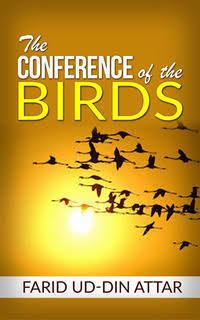Originally published 1177 Genre Epic poetry | ||
 | ||
Characters Simurgh, Chamberlain, peacock, parrot, Duck, Partridge, Owl, hoopoe, Sparrow, nightingale, Heron, Falcon, Dove Similar Works by Attar of Nishapur, Epic poetry books, Sufism books | ||
Jamal rahman the conference of the birds
The Conference of the Birds or Speech of the Birds (Persian: منطق الطیر, Manṭiq-uṭ-Ṭayr, also known as مقامات الطیور Maqāmāt-uṭ-Ṭuyūr; 1177), is a celebrated literary masterpiece of Persian literature by poet Farid ud-Din Attar, commonly known as Attar of Nishapur.
Contents
In the poem, the birds of the world gather to decide who is to be their king, as they have none. The hoopoe, the wisest of them all, suggests that they should find the legendary Simorgh, a mythical Persian bird roughly equivalent to the western phoenix. The hoopoe leads the birds, each of whom represent a human fault which prevents man from attaining enlightenment. From the many birds that begin the journey, only thirty birds are left that finally reach the dwelling place of the Simorgh. There, the birds see the Simorgh in the reflection of their faces of an implicit lake.
If Simorgh unveils its face to you, you will findthat all the birds, be they thirty or forty or more,are but the shadows cast by that unveiling.What shadow is ever separated from its maker?Do you see?The shadow and its maker are one and the same,so get over surfaces and delve into mysteries.The seven valleys the birds cross are as follows:
1. Valley of the Quest, where the Wayfarer begins by casting aside all dogma, belief, and unbelief.2. Valley of Love, where reason is abandoned for the sake of love.3. Valley of Knowledge, where worldly knowledge becomes utterly useless.4. Valley of Detachment, where all desires and attachments to the world are given up. Here, what is assumed to be “reality” vanishes.5. Valley of Unity, where the Wayfarer realizes that everything is connected and that the Beloved is beyond everything, including harmony, multiplicity, and eternity.6. Valley of Wonderment, where, entranced by the beauty of the Beloved, the Wayfarer becomes perplexed and, steeped in awe, finds that he or she has never known or understood anything.7. Valley of Poverty and Annihilation, where the self disappears into the universe and the Wayfarer becomes timeless, existing in both the past and the future.Attar's masterful use of symbolism is a key, driving component of the poem. This adroit handling of symbolisms and allusions can be seen reflected in these lines:
It was in China, late one moonless night, The Simorgh first appeared to mortal sight – Beside the symbolic use of the Simorgh, the allusion to China is also very significant. According to Idries Shah, China as used here, is not the geographical China, but the symbol of mystic experience, as inferred from the Hadith (declared weak by Ibn Adee, but still used symbolically by some Sufis): "Seek knowledge; even as far as China".[5] There are many more examples of such subtle symbols and allusions throughout the Mantiq. Within the larger context of the story of the journey of the birds, Attar masterfully tells the reader many didactic short, sweet stories in captivating poetic style. The book is meant to be not only instructive but also entertaining.
English translations
"The Conference of the Birds" translated by Sholeh Wolpe, W. W. Norton & Co 2017'"The Conference of the Birds" translated by Afkham Darbandi and Dick Davis, Penguine Classics 1984La Conférence des oiseaux
Peter Brook and Jean-Claude Carrière adapted the poem into a play titled La Conférence des oiseaux (The Conference of the Birds), which they published in 1979. Brook toured the play around rural Africa before presenting two extremely successful productions to Western audiences—one in New York City at La MaMa, E.T.C. and one in Paris.
